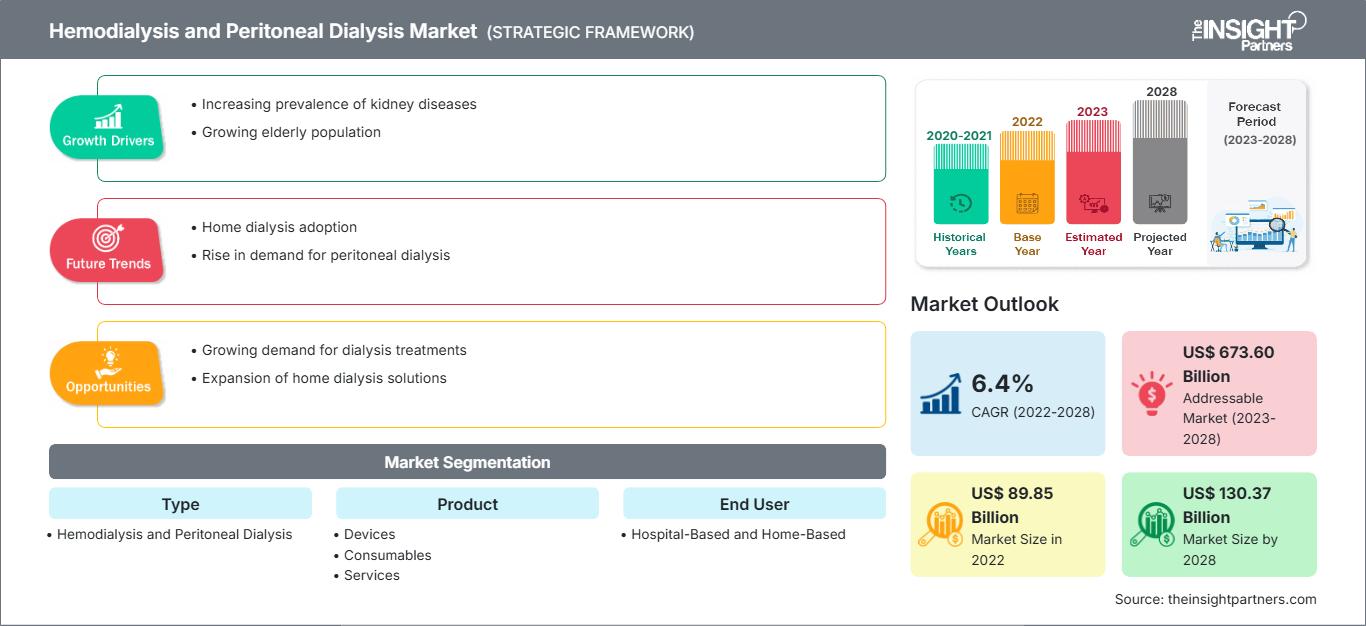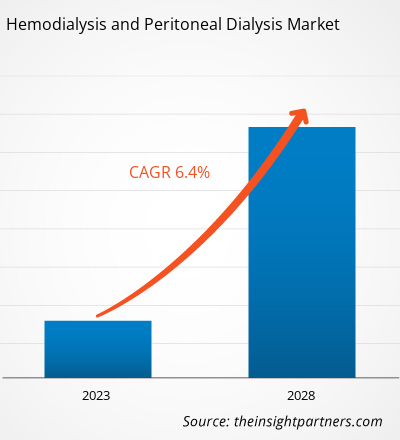Si prevede che il mercato dell'emodialisi e della dialisi peritoneale raggiungerà i 130.370,18 milioni di dollari entro il 2028, rispetto agli 89.851,61 milioni di dollari del 2022; si prevede una crescita a un CAGR del 6,4% dal 2022 al 2028.
Esistono due tipi di dialisi. Nell'emodialisi, il sangue viene pompato fuori dal corpo del paziente verso una macchina che simula un rene artificiale e reimmesso nel corpo del paziente tramite tubi collegati alle macchine. Nella dialisi peritoneale, il rivestimento interno dell'addome del paziente funge da filtro naturale.
Il mercato dell'emodialisi e della dialisi peritoneale è segmentato in base a tipologia, prodotto, utente finale e area geografica. Per area geografica, il mercato è ampiamente segmentato in Nord America, Europa, Asia-Pacifico, Medio Oriente e Africa e Sud e Centro America. Il rapporto sul mercato dell'emodialisi e della dialisi peritoneale offre approfondimenti e analisi approfondite del mercato, evidenziando parametri quali dimensioni del mercato, tendenze, progressi tecnologici e dinamiche di mercato, nonché l'analisi del panorama competitivo dei principali attori del mercato a livello globale. Inoltre, il rapporto include l'impatto della pandemia di COVID-19 sul mercato dell'emodialisi e della dialisi peritoneale in tutte le regioni.
La crescita del mercato dell'emodialisi e della dialisi peritoneale è attribuita all'aumento del numero di pazienti con ESRD, all'aumento dell'incidenza di insufficienza renale e disfunzione renale cronica nella popolazione e alla scarsità di donatori di organi. Tuttavia, le preoccupazioni relative ai rimborsi nei mercati emergenti limitano la crescita del mercato.
Personalizza questo rapporto in base alle tue esigenze
Potrai personalizzare gratuitamente qualsiasi rapporto, comprese parti di questo rapporto, o analisi a livello di paese, pacchetto dati Excel, oltre a usufruire di grandi offerte e sconti per start-up e università
Mercato dell'emodialisi e della dialisi peritoneale: Approfondimenti strategici

- Ottieni le principali tendenze chiave del mercato di questo rapporto.Questo campione GRATUITO includerà l'analisi dei dati, che vanno dalle tendenze di mercato alle stime e alle previsioni.
Potrai personalizzare gratuitamente qualsiasi rapporto, comprese parti di questo rapporto, o analisi a livello di paese, pacchetto dati Excel, oltre a usufruire di grandi offerte e sconti per start-up e università
Mercato dell'emodialisi e della dialisi peritoneale: Approfondimenti strategici

- Ottieni le principali tendenze chiave del mercato di questo rapporto.Questo campione GRATUITO includerà l'analisi dei dati, che vanno dalle tendenze di mercato alle stime e alle previsioni.
Approfondimenti di mercato
La crescente prevalenza di malattie renali stimola la crescita del mercato dell'emodialisi e della dialisi peritoneale
La malattia renale cronica (MRC) e l'insufficienza renale acuta (IRA) sono condizioni in cui i reni sono danneggiati e non riescono a filtrare correttamente il sangue. Per questo motivo, liquidi in eccesso e scorie del sangue rimangono nell'organismo, il che può causare altri problemi di salute come malattie cardiache e ictus. La MRC di solito peggiora nel tempo, anche se il trattamento ha mostrato una lenta progressione. Se la MRC non viene trattata, può progredire in insufficienza renale e malattie cardiovascolari precoci. Nella MRC, quando i reni smettono di funzionare, la dialisi o il trapianto di rene sono necessari per la sopravvivenza. Quando trattata con dialisi o trapianto di rene, questa insufficienza renale è chiamata malattia renale allo stadio terminale (ESRD). Secondo i Centers for Disease Control and Prevention (CDC), circa 36 milioni di adulti soffrono di MRC negli Stati Uniti. Inoltre, ogni 24 ore, 360 persone iniziano il trattamento dialitico per insufficienza renale. Nel 2017, sono stati registrati 697,5 milioni di casi di malattia renale cronica (MRC) (in tutti gli stadi) in tutto il mondo, con una prevalenza globale del 9,1%. La crescente prevalenza di malattia renale allo stadio terminale (ESRD) è anche uno dei principali fattori che guidano il mercato. Ad esempio, secondo lo United States Renal Data System (USRDS), quasi 786.000 persone nel Paese convivono con malattia renale allo stadio terminale (ESRD). Pertanto, la crescente prevalenza di malattia renale cronica, danno renale acuto e malattia renale allo stadio terminale, che porta alla dialisi, sta trainando il mercato dell'emodialisi e della dialisi peritoneale.
Approfondimenti basati sulla tipologia
In base alla tipologia, il mercato dell'emodialisi e della dialisi peritoneale si divide in emodialisi e dialisi peritoneale. Nel 2022, il segmento dell'emodialisi ha detenuto una quota di mercato maggiore. Inoltre, si prevede che lo stesso segmento registrerà un CAGR più elevato, pari al 6,7%, durante il periodo di previsione.
Approfondimenti basati sul prodotto
In base al prodotto, il mercato dell'emodialisi e della dialisi peritoneale è segmentato in dispositivi, materiali di consumo e servizi. Il segmento dei servizi ha detenuto la quota di mercato maggiore nel 2022. Tuttavia, si prevede che il segmento dei materiali di consumo registrerà il CAGR più elevato, pari al 7,5%, durante il periodo di previsione.
Approfondimenti basati sull'utente finale
In base all'utente finale, il mercato dell'emodialisi e della dialisi peritoneale è segmentato in ospedaliero e domiciliare. Il segmento ospedaliero ha detenuto una quota maggiore nel 2022. Tuttavia, si prevede che il segmento domiciliare registrerà un CAGR più elevato del 7,4% durante il periodo di previsione.
Gli operatori del mercato dell'emodialisi e della dialisi peritoneale adottano strategie organiche, come il lancio e l'espansione dei prodotti, per espandere la propria presenza e il portafoglio prodotti in tutto il mondo, nonché per soddisfare la crescente domanda.
Approfondimenti regionali sul mercato dell'emodialisi e della dialisi peritoneale
Le tendenze regionali e i fattori che influenzano il mercato dell'emodialisi e della dialisi peritoneale durante il periodo di previsione sono stati ampiamente spiegati dagli analisti di The Insight Partners. Questa sezione illustra anche i segmenti e la geografia del mercato dell'emodialisi e della dialisi peritoneale in Nord America, Europa, Asia-Pacifico, Medio Oriente e Africa, America meridionale e centrale.
Ambito del rapporto di mercato sull'emodialisi e la dialisi peritoneale
| Attributo del rapporto | Dettagli |
|---|---|
| Dimensioni del mercato in 2022 | US$ 89.85 Billion |
| Dimensioni del mercato per 2028 | US$ 130.37 Billion |
| CAGR globale (2022 - 2028) | 6.4% |
| Dati storici | 2020-2021 |
| Periodo di previsione | 2023-2028 |
| Segmenti coperti |
By Tipo
|
| Regioni e paesi coperti | Nord America
|
| Leader di mercato e profili aziendali chiave |
|
Densità degli operatori del mercato dell'emodialisi e della dialisi peritoneale: comprendere il suo impatto sulle dinamiche aziendali
Il mercato dell'emodialisi e della dialisi peritoneale è in rapida crescita, trainato dalla crescente domanda degli utenti finali, dovuta a fattori quali l'evoluzione delle preferenze dei consumatori, i progressi tecnologici e una maggiore consapevolezza dei benefici del prodotto. Con l'aumento della domanda, le aziende stanno ampliando la propria offerta, innovando per soddisfare le esigenze dei consumatori e sfruttando le tendenze emergenti, alimentando ulteriormente la crescita del mercato.

- Ottieni il Mercato dell'emodialisi e della dialisi peritoneale Panoramica dei principali attori chiave
Per area geografica
In base all'area geografica, il mercato dell'emodialisi e della dialisi peritoneale è segmentato in Nord America (Stati Uniti, Canada e Messico), Europa (Regno Unito, Germania, Francia, Italia, Spagna e resto d'Europa), Asia Pacifico (Cina, Giappone, India, Australia, Corea del Sud e resto dell'Asia Pacifico), Medio Oriente e Africa (Emirati Arabi Uniti, Arabia Saudita, Sudafrica e resto del Medio Oriente e dell'Africa) e Sud e Centro America (Brasile, Argentina e resto del Sud e Centro America). Alcuni dei principali attori coinvolti nel mercato sono Fresenius Medical Care AG & Co KGaA; DaVita Inc.; Baxter International Inc.; B. Braun Melsungen AG; Diaverum; Nipro Medical Corporation; Asahi Kasei Medical Co., Ltd.; Rockwell Medical, Inc.; e Dialife SA.
- Analisi storica (2 anni), anno base, previsione (7 anni) con CAGR
- Analisi PEST e SWOT
- Valore/volume delle dimensioni del mercato - Globale, Regionale, Nazionale
- Industria e panorama competitivo
- Set di dati Excel
Report recenti
Testimonianze
Motivo dell'acquisto
- Processo decisionale informato
- Comprensione delle dinamiche di mercato
- Analisi competitiva
- Analisi dei clienti
- Previsioni di mercato
- Mitigazione del rischio
- Pianificazione strategica
- Giustificazione degli investimenti
- Identificazione dei mercati emergenti
- Miglioramento delle strategie di marketing
- Aumento dell'efficienza operativa
- Allineamento alle tendenze normative




















 Ottieni un campione gratuito per - Mercato dell'emodialisi e della dialisi peritoneale
Ottieni un campione gratuito per - Mercato dell'emodialisi e della dialisi peritoneale